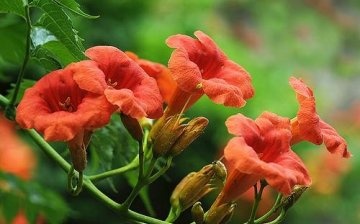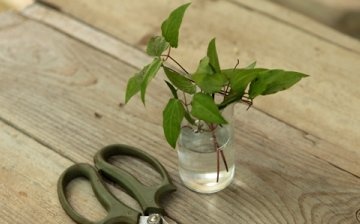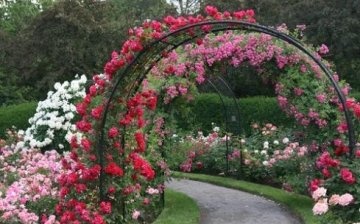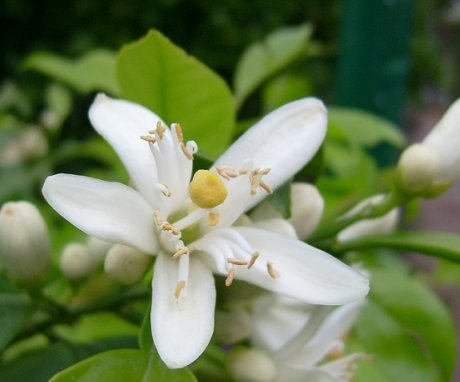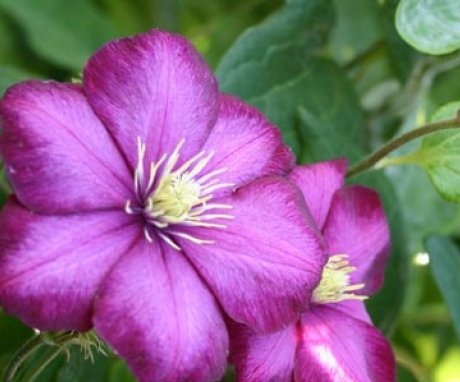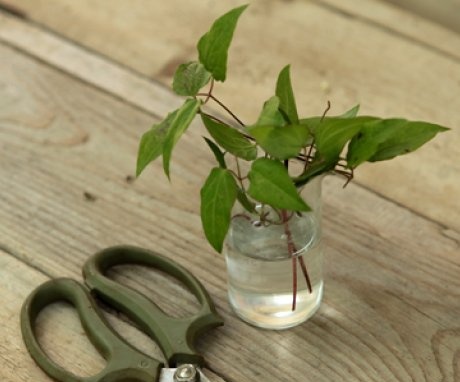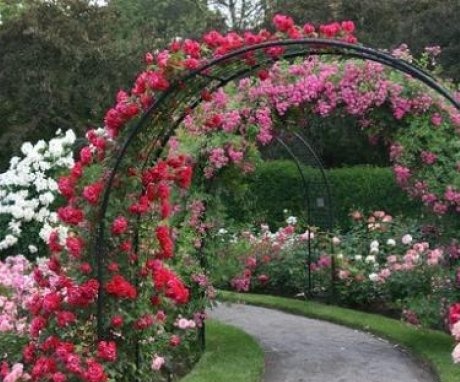The most beautiful flowering vines for the garden
The garden is decorated with flower beds, rockeries, rabatoks and flowering vines. The latter are considered one of the most common ways of landscaping vertical structures, walls of houses and fences. The loaches wrap the surfaces in a dense, bright green carpet strewn with flowers.
Even the most ordinary-looking house with peeling walls will look like a luxurious mansion. Blooming vines are used in landscape design not only because of their decorative properties, but also because of the unpretentiousness of plants. The main thing to do is to choose the right liana and choose a suitable support.
Content:
Types of flowering vines
There are a huge number of plants that quickly and tightly wrap around the supports. Of all the variety, you need to select those that are suitable for a specific region. It is also worth considering the features of the site and soil mixture. It is from these criteria that they are repelled when choosing vines.
There are the following types of flowering vines for landscaping vertical supports:
- Maiden grapes... A perennial plant that can wrap around any wall in a fairly short time. It grows up to four meters per year. Maiden grapes are appreciated for their unpretentiousness and wondrous beauty of foliage. It looks especially impressive in autumn - the leaves acquire a golden-purple hue. Liana grows very quickly, so its growth must be limited. Otherwise, it will surround the whole house along with the roof, which is undesirable for the building structure. The weight of the vines is impressive, consider this when choosing a plant.
- Ivy... Another perennial, delighting with dense greenery. There are practically no flowers on the bindweed, the plant is valued for its foliage and the ability to quickly twine around any supports. Hard winters are unlikely to endure without shelter, in the heat it can burn out. Despite this, ivy is classified as an unpretentious plant. It grows very quickly, the growth of ivy must be controlled. Otherwise, it will spread throughout the entire site. The plant is well suited for the middle lane and southern regions. In Siberia, it often freezes out in winter. Although it is possible to find ivy varieties for this region.
- Hop... Perennial plant, unpretentious. Hops are not only beautifully wrapped around vertical supports, but also a medicinal plant. However, it has one drawback - it grows very quickly, its seeds are spread throughout the site. It is very difficult to keep track of its distribution throughout the territory. Consider this fact if you want to plant hops. The plant wraps around any support with lightning speed, greenery is decorated with light green cones.
- Climbing rose. Perennial flowering liana is known for its luxurious flowering, small-sized roses are densely strewn on a green carpet of greenery. A climbing rose is usually planted next to the entrance groups in the form arches... The plant effectively braids the arc. Rose is more demanding for care and soil mixture. It does not tolerate winters well, so the plant needs to be covered with non-woven material and sawdust. A wooden box is installed on top. If the climbing beauty grows in the southern regions, no shelter is required for it.
- Campsis... This perennial is distinguished by its exquisite flowering. Its inflorescences resemble elongated bells, they are collected in a bunch and hang effectively against the background of lush greenery.The color range of colors is different. You need to choose the right variety. The plant is unpretentious, but requires attention when planting. It is difficult to take root in a new place. It tolerates winter well, but after a long time comes to its senses. It blooms throughout the summer season. Can be grown in any region. In Siberia, Kampsis is sheltered for the winter.
- Actinidia... A perennial plant known for its wondrous beauty of greenery and bright orange berries. The fruits adorn the vine in winter. They look spectacular against the background of snow-white snow, which wrapped the unsightly branches of the plant. Actinidia is an unpretentious vine, it tolerates winter well. The main point in the care is abundant watering. If this condition has been met, actinidia tolerates well even a harsh winter.
- Wisteria... A southern perennial that is common in Japan and China. The bloom of wisteria is so luxurious that special gardens are laid out for the plant, where everyone can admire the exquisite flowers. The inflorescences hang in bunches and form a real paradise with a fragrant aroma. Wisteria is moody and will thrive in a sunny location with fertile and light soil. She does not tolerate dampness. For the winter, it is advisable to remove it from the supports and cover it with non-woven material. The weight of the creeper is large, take this into account when planting and choosing a support.
- Clematis... There are many varieties and types of clematis. Curly varieties are chosen for vertical gardening. With the help of antennae, the plant clings to the support and gradually wraps around it. Clematis is more often used for landscaping verandas, gazebos and trellises. The plant blooms with rather large flowers of various colors - purple, white or blue. Some varieties of vines are known for the wonderful scent of flowers that spreads throughout the site. Clematis are unpretentious, but they will feel better on the sunny side. They are successfully grown even in the northern regions, where the plant takes shelter for the winter.
- Honeysuckle... In addition to bush honeysuckle, there are climbing species of this plant. They braid the support pretty quickly. Honeysuckle tolerates winters well and requires shelter only in the first two years. In autumn, the plant is thinned out, dead shoots are removed. Some varieties of honeysuckle have fragrant flowers. Their scented veil becomes more intense in the evening.
These are the most common and unpretentious plants. They beautifully wrap around the walls of houses, fences, arches and pergolas. Before making a choice, you should take into account the characteristics of plants - perennials or annuals. Let's consider each type and decide on their purpose in the garden.
Among annuals, it is worth highlighting such vines as sweet peas, ornamental beans, Ipomoya or passionflower.
All these types of vines are distinguished by lush flowering and rapid growth. However, they do not tolerate winter well and often freeze out. Therefore, they are grown as annuals. When choosing flowering vines, be sure to pay attention to their weight and conditions of detention. For example, wisteria cannot be planted in the Urals. Consider the characteristics of the plant.
Breeding methods and planting vines
Flowering vines can be propagated and seeds, and cuttings... It all depends on their type. For example, flowering annuals are more often propagated by seeds, perennials - by green cuttings or shoots.
When planting seed, take into account the peculiarities of the lian and the requirements for the soil mixture.
Although for most perennial vines, the composition of the earth does not matter. For a climbing rose and wisteria it is better to select fertile soil, it should be loose and breathable.
The seeds of some vines can be planted in the spring, and some before winter. Always consider the nuances of reproduction of flowering, climbing plants.
Landing features:
- Almost all types of flowering lianas prefer sunny places, protected from northerly winds. The only exception is maiden grapes, which can grow on both the southern and northern sides.The rest of the species require a lot of light and fertile soil.
- For planting seedlings, choose free areas so that the vines do not drown out other ornamental plants.
- The distance between seedlings depends on the type of vines. Girlish grapes, Kampsis, clematis or wisteria are planted at a distance of 50 to 100 cm.Annual crops usually do not have a large root system, the distance between them can be reduced to 30 cm.
- Particular attention should be paid to climbing roses. They love warm and sunny places. Demanding on the soil. Humus is introduced into the soil and mineral fertilizers, mix everything well. On poor lands, the rose will not bloom, the greenery will fall off and turn yellow.
Before planting flowering vines, be sure to study the growing conditions and characteristics of the plant. Despite their unpretentiousness, they still have some requirements for the soil and place of detention.
Correct care
Climbing plants are easy to care for. However, there are nuances regarding some species. Actinidia requires abundant watering. A climbing rose needs to be fertilized mineral fertilizers three times during the growing season. Heat-loving vines must be covered with spruce branches, sawdust or non-woven material for the winter. Almost all types require trimming after flowering and before it. Unnecessary shoots are removed, growth is regulated by trimming the upper lashes. If you do not monitor the distribution of plants, they grow throughout the site and it will be very difficult to remove them. This is especially true for hops and clematis.
The rest of the vines do not require special action. The main thing is to put the support on time. This is done before planting seedlings, and not after. The material of the supports is selected depending on the weight of the vines. The grapes require powerful structures, since their weight is very significant. Always consider this nuance.
When choosing a plant, you need to take into account not only the characteristics of the plant, but also its appearance.
Massive branches will not look on a small pergola or trellis. Such plants are planted for the purpose of landscaping the walls of houses, large verandas, gazebos and stone fences. Trellises or small structures are best decorated with annuals. They are lighter, easier to care for and guide.
Gardeners are advised not to dwell on capricious vines. They need careful, daily care, which is not very convenient. Most people prefer to plant a plant and forget about it for the entire season. Almost all vines meet these requirements with the exception of roses and southern species of loaches.
If you decide to grow grapes as a decorative vertical element, do not let them grow and climb onto the roof of the house. Branches eventually destroy the roof and penetrate into the room. This has happened many times. Therefore, it is important to limit the growth of the grapes and not allow them to twine more than it should.
Support selection
Before planting a flowering liana, decide on the support that it will wrap around. This activity should be approached responsibly. A fragile and unreliable support can bend or break under the weight of the plant. The choice of material for the vertical structure is also important. It should be remembered that the tree is not durable and quickly decays under the influence of the environment. For this reason, the material is treated with antiseptics and painted.
For heavy perennial vines, the following types of supports are more often chosen:
- Pergolas - this structure is an arch, consisting of several arched sections, which are interconnected by transverse beams. The material of manufacture is metal, wood or stone.
- Curly contours of large sizes - the structure is constructed from steel rods in the form of different shapes.
- Tripods or turrets - the structure is made of metal or wood. Usually they are installed next to the entrance groups to the garden.
- Trellis - this type of support is best made of steel or wood.Often, the trellis is installed next to the walls of a house or veranda so that the plant curls along the support, and not along the wall itself. This will prevent the walls from collapsing from the constant pressure of the vines.
- Arches - they are made of metal, less often of wood. Both heavy and light vines can be lowered onto the arch.
Depending on the type of liana, choose a support. The main thing is to make a solid and reliable structure so that it will not be blown away by the wind. If everything is done correctly, the peculiarities of the plant, the conditions for its cultivation are taken into account, the vine will quickly wrap up the vertical and will delight the gardener with luxurious flowering and lush greenery!
More information can be found in the video:



